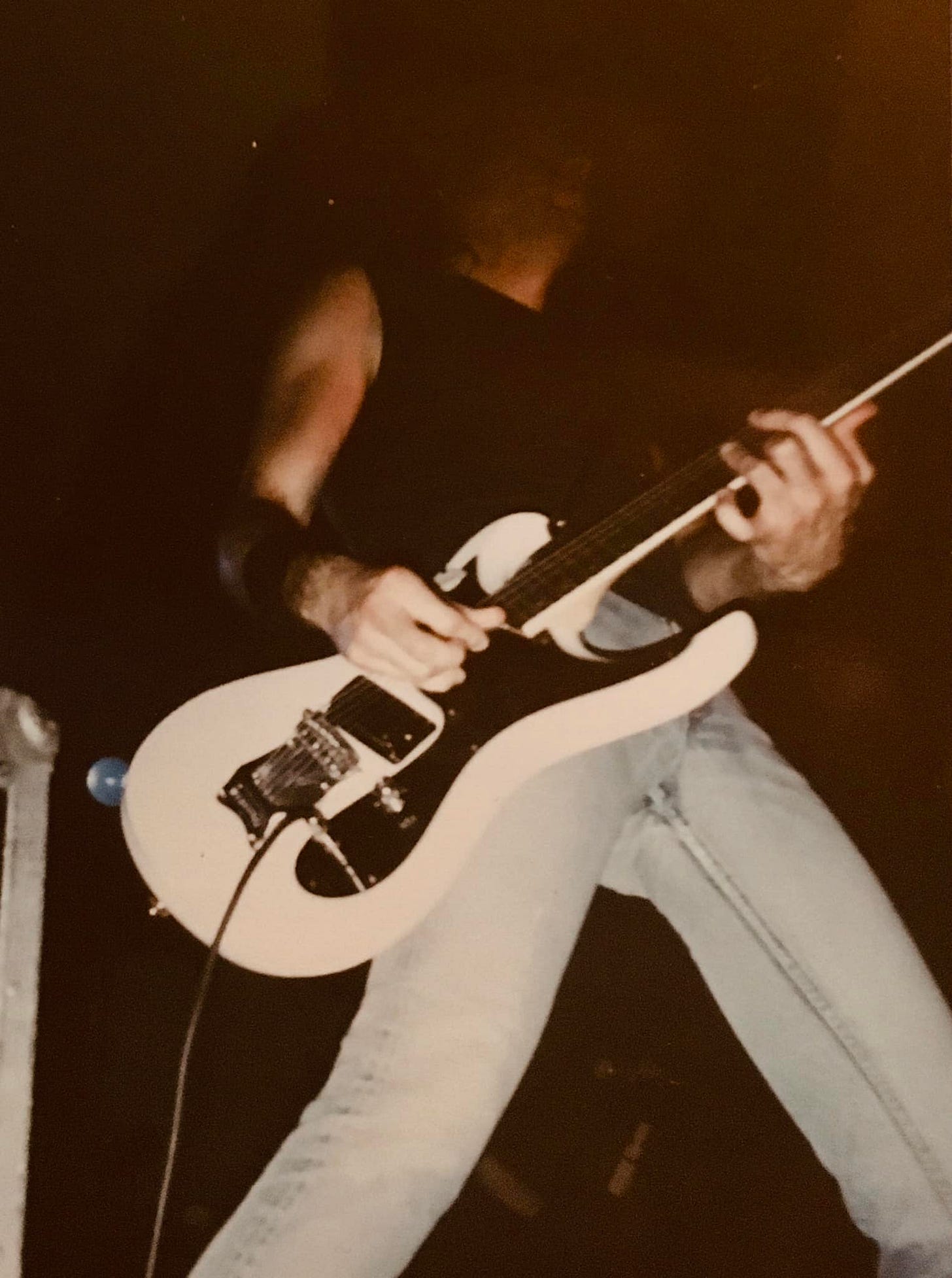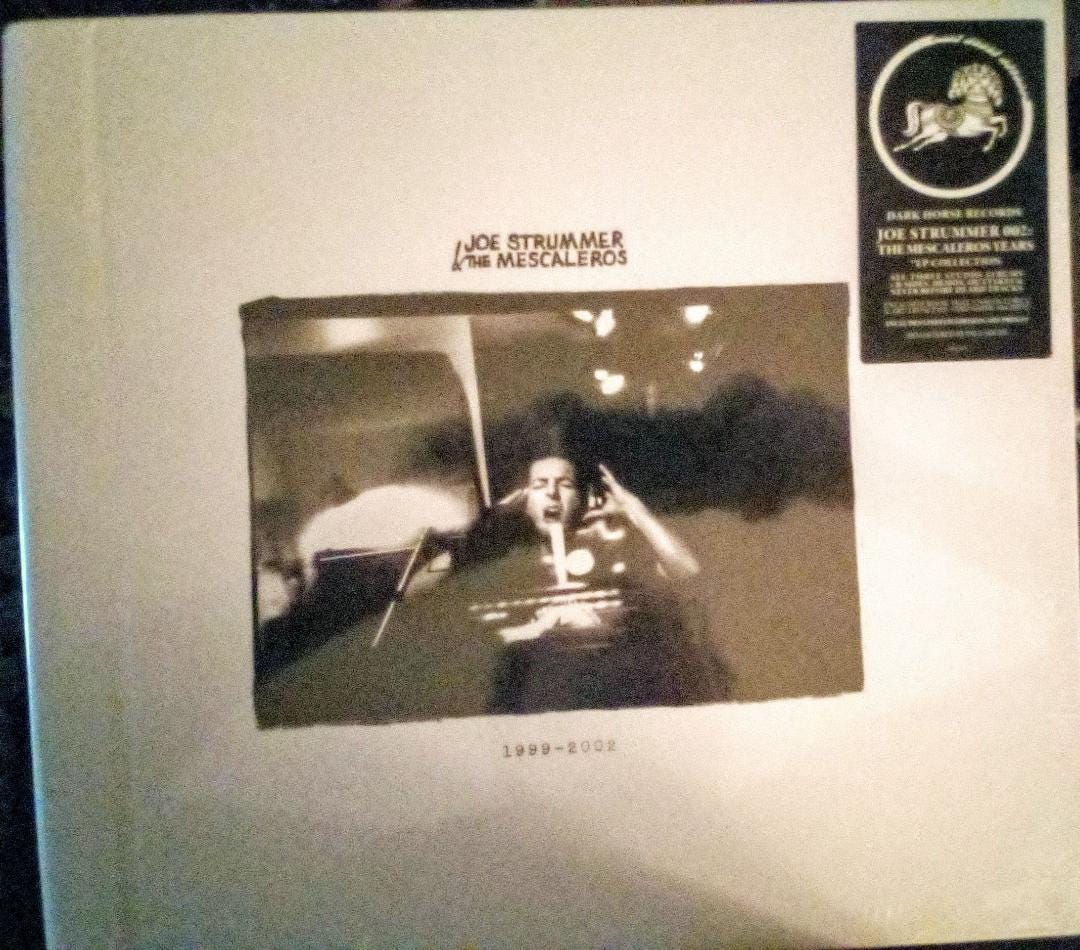Parade Of Great Guitarists: Johnny Ramone
A revival and expansion of a series I undertook at Instagram and Facebook two years ago, commencing with the man who changed the universe with two infinitely transposed barre chords.
I am in love with the electric guitar. I am in love with guitar players. I am in love with the peripherals and associated technology tied in with the electric guitar. It is the chief musical signature of rock ‘n’ roll, and holds an infinite variety of sonic and textural possibilities. It also is the favored tool in blues, country, soul, rhythm & blues, and other worthwhile musics. It’s the very fucking substance of existence.
However, I am not in love with the standard electric guitar canon most folks follow. It isn’t about how many widdly-widdly notes you can squeeze into a single bar of music. It’s about tone, attack, and the emotions you can arouse with six strings – 12, if you’re in The Byrds or The Beatles. I would rather hear a broken-down, drunken, stumblebum sumbitch playing one note on a five buck Japanese ‘60s Masonite-body thing with five broken strings than some poodle-haired chops wizard wailing away on the lessons he just picked up at GIT the other day.
A few years back, I attempted to codify a different sort of rock ‘n’ roll guitar canon, one that favors attitude over virtuosity, emotion over perfection. Sam Phillips used to tell Carl Perkins, when he complained he’d made a mistake during a take, “Hell, son! That’s original!” Sometimes, accidents can elevate a song into the realm of the Gods.
With this in mind, The Tim “Napalm” Stegall Substack reintroduces the Parade Of Great Guitarists series in a newly expanded format, beginning with the man who – alongside Keith Richards – introduced many of us to the importance of well-executed rhythm guitar.
Johnny Ramone was born John William Cummings in Queens, NY on October 8, 1948, and died in Los Angeles on September 15, 2004, after a five year battle with prostate cancer. In between, he wrote the punk guitar primer.
Two barre chord positions, transposed up and down the neck. Contrary to popular belief, Johnny did not play power chords. Those are only two notes – the first and the fifth. Instead, he spent the Ramones’ entire career hitting full-on six string barre chords, through a dimed Marshall. The resultant barrage of distorted overtones created this overloaded frequency spectrum that contributed to the sonic fullness of the Ramones. Then there’s the matter of his attack: Johnny Ramone did not strum. He downstroked rapid fire eighth notes, picked down-down-down, reportedly in the manner of Jimmy Page on Led Zeppelin’s protopunk raver “Communication Breakdown.” And there were full-on rests and unique phrasing to the ramalama. This is what eludes many seeking to pull on Johnny’s well-worn Keds.
He relied on instinct and his own impatience more than anything. After seeing the New York Dolls and realizing he could do this himself, roping his buddy Douglas Colvin into his idea to start their own ‘70s rock ‘n’ roll band, he was so eager to begin that he grabbed the first and cheapest instrument he found on 48th Street – a $54 Mosrite Ventures II. (Colvin, the future Dee Dee Ramone, similarly reached for a Danelectro bass.) It turned out to be a choice uniquely and identifiably his own, rather than the standard Stratocasters and Les Pauls favored by most rock guitarists. When the stock Mosrite pickup shorted from absorbing the sweat pouring off his arms in the endurance marathons that were live Ramones shows, he almost as haphazardly had a Dimarzio Fat Strat installed, a single coil with a midrange spike to compete with Gibson’s tones. This aided immensely in that chainsaw guitar sound.
He was as hard-nosed and no-bullshit in his approach in every other aspect of guitar playing as in his dogged pursuit of the ramalama. In conducting interviews for an aborted Guitar World feature in 1991, I asked both Johnny and Dee Dee’s replacement CJ Ramone how low a Ramones guitar should be slung. CJ went into a lengthy technical explanation of how those guitars needed to hang practically to your sneakers, due to the ergonomics of playing those relentless downstrokes. It apparently eased fatigue, prevented carpal tunnel syndrome, etc.
Johnny smiled and replied, “Well, when I first got a guitar, I stood in front of a mirror and adjusted it until it looked cool.” And it remained evermore, until his death.
The glorious results of adjusting a guitar strap in front of a mirror until it looks cool, snapped by Pete Hembree. (Courtesy Rick Johnson)
One other mindblowing tidbit from this unpublished interview: Johnny claimed he played .008 to .038 gauge strings – the next-to-the-lightest strings on the market, what Ernie Ball calls the Extra Slinky set! I wondered aloud how he didn’t break all six strings on the evening’s first downstroke!
“I probably have a lighter touch than it looks,” he chuckled. Which must be true, as his attack was all in the wrist.
And about that attack: It wasn’t RAMALAMALAMALAMALAMA! It was RAM! RAMALAMALAMA! RAM! RAMALAMALAMA! It had accents. More dynamic that way.
Johnny Ramone never changed. He began with that ramalama guitar sound, never once playing a solo, and just refined it repeatedly until the Ramones’ 1996 retirement. Some felt the Ramones ran themselves into a stylistic ditch, becoming formulaic. Hardly true. There were little subtle shifts and changes as time went on. But Johnny’s ramalama was the bedrock upon which those changes were built.
However, what might be Johnny Ramone’s ultimate contribution to the art of punk rock guitar has to be the first Ramones album from 1976. Using the odd stereo mixes of the first Beatles albums from ‘64 and ‘65 as a blueprint, Da Brudders insisted producer Craig Leon pan Johnny’s guitar hard left, and Dee Dee’s bass hard right. This accidentally created punk’s equivalent to the old Play Guitar With The Ventures guitar instruction records: You could turn your stereo balance knob to the left and learn Johnny’s parts, then pan it to the right and play along with Tommy and Dee Dee! An entire generation learned to play guitar thusly.
There were many other things one could learn from Johnny Ramone, mostly attitudinally and aesthetically: Attack your guitar like you're pissed off, the black leather jacket is not a garment but a way of life, etc., etc. But scratch any punk rock guitarist worth his salt, you’re gonna find at least an iota of Johnny Ramone underneath. And probably guitarists from almost any other genre, to boot. This is not a bad thing.
The Joe Strummer box set featuring my liner notes is out now
Yes, while Cheeto Mussolini was having his tailors fit him for orange jumpsuits (dare we hope?!), Dark Horse Records dropped the Joe Strummer 002: The Mescaleros Years box set, featuring my liner notes. No, my name is not screamed from the sticker or anything, nor did Henry Rollins say anything in that unboxing video. But I didn’t expect that. This is about Joe Strummer, not me.
I am content with my byline popping up on the credits page in the gorgeous booklet, and the honor of Joe’s estate commissioning my writing for this worthy project. I have not had a chance to listen to the records or CDs yet, nor will I be reviewing this here or in another publication – that would be a violation of journalistic ethics. But I will gladly direct you to order your copy by clicking here.
Thank you for reading the inaugural Parade Of Great Guitarists installment. Who would you like to see covered in this series? Leave your suggestions in the comments. Friday: The conclusion of that sprawling Clash Combat Rock appreciation (finally!). Coming soon: Reviews of ex-Radio Birdman guitarist Chris “Klondike” Masuak’s new book and the Moonage Daydream David Bowie documentary! Please support The Tim “Napalm” Stegall Substack with a free or paid subscription, and by sharing this piece. And remember: You pay more for coffee each day than a five dollar monthly subscription to this site.
#timstegall #timnapalmstegall #timnapalmstegallsubstack #punkjournalism #paradeofgreatguitarists #johnnyramone #ramones #barrechords #downstrokes #mosriteventuresII #marshallamps #rhythmguitarisgod #joestrummer002 #themescalerosyears #boxset #timstegalllinernotes








Chris Spedding
My punk side is obviously going to vote for Greg Ginn, D. Boon, and Curt Kirkwood, first off. And then add Neil Young for dessert.